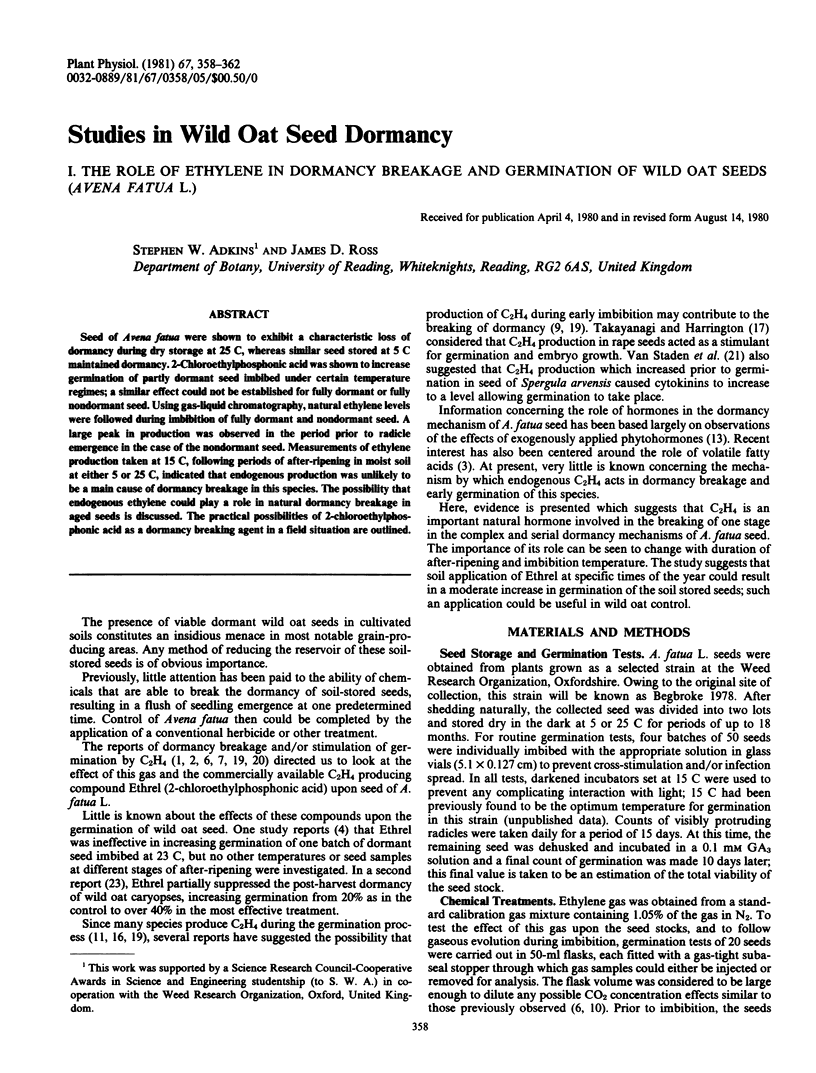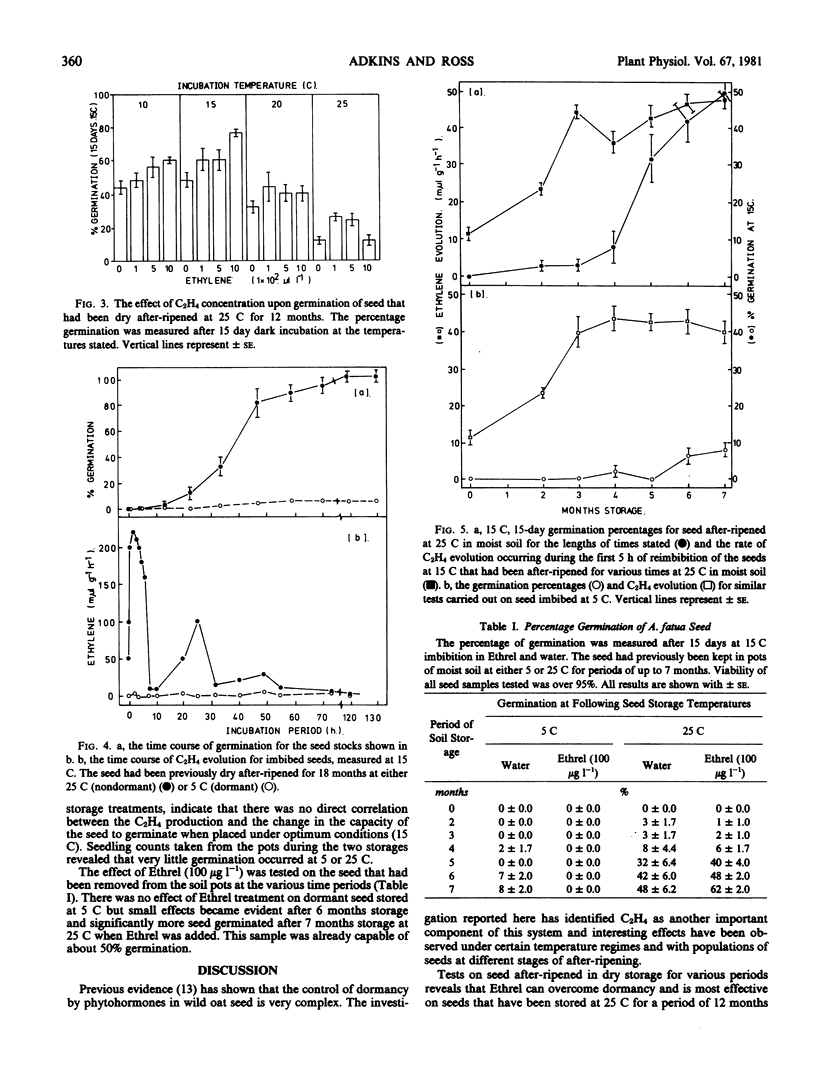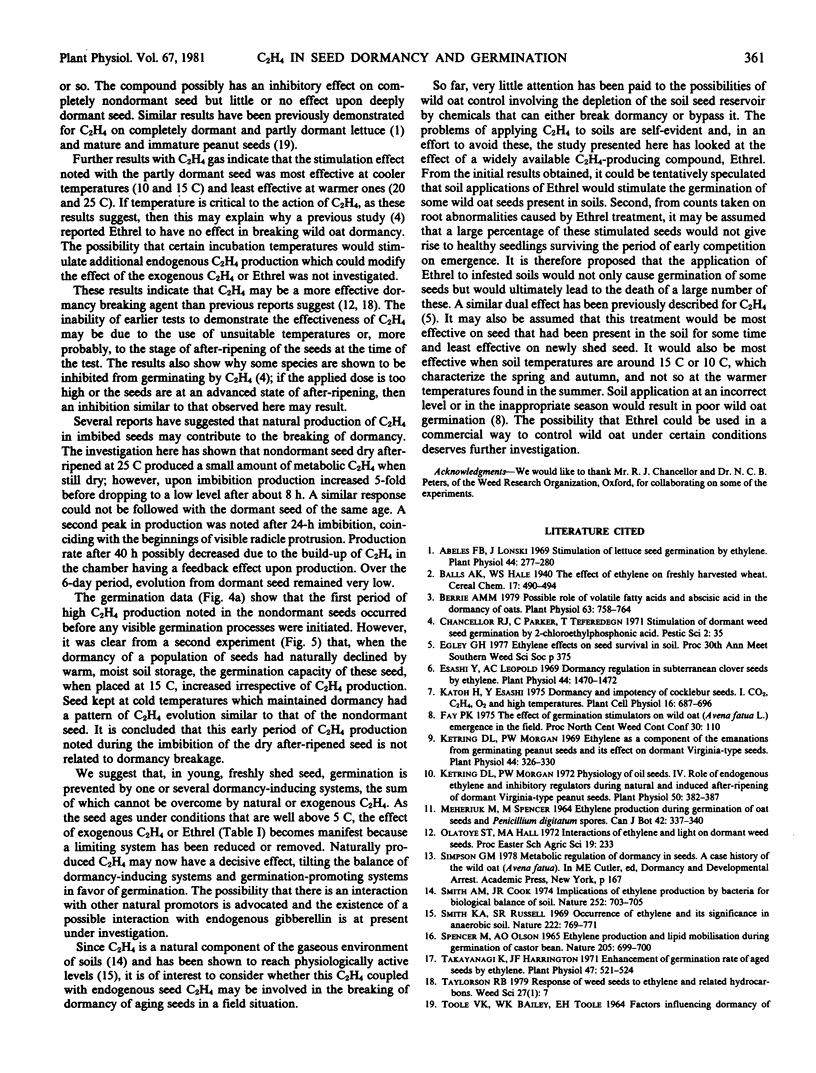Abstract
Seed of Avena fatua were shown to exhibit a characteristic loss of dormancy during dry storage at 25 C, whereas similar seed stored at 5 C maintained dormancy. 2-Chloroethylphosphonic acid was shown to increase germination of partly dormant seed imbibed under certain temperature regimes; a similar effect could not be established for fully dormant or fully nondormant seed. Using gas-liquid chromatography, natural ethylene levels were followed during imbibition of fully dormant and nondormant seed. A large peak in production was observed in the period prior to radicle emergence in the case of the nondormant seed. Measurements of ethylene production taken at 15 C, following periods of after-ripening in moist soil at either 5 or 25 C, indicated that endogenous production was unlikely to be a main cause of dormancy breakage in this species. The possibility that endogenous ethylene could play a role in natural dormancy breakage in aged seeds is discussed. The practical possibilities of 2-chloroethylphosphonic acid as a dormancy breaking agent in a field situation are outlined.
Full text
PDF




Selected References
These references are in PubMed. This may not be the complete list of references from this article.
- Abeles F. B., Lonski J. Stimulation of lettuce seed germination by ethylene. Plant Physiol. 1969 Feb;44(2):277–280. doi: 10.1104/pp.44.2.277. [DOI] [PMC free article] [PubMed] [Google Scholar]
- Berrie A. M. Possible role of volatile Fatty acids and abscisic Acid in the dormancy of oats. Plant Physiol. 1979 Apr;63(4):758–764. doi: 10.1104/pp.63.4.758. [DOI] [PMC free article] [PubMed] [Google Scholar]
- Esashi Y., Leopold A. C. Dormancy regulation in subterranean clover seeds by ethylene. Plant Physiol. 1969 Oct;44(10):1470–1472. doi: 10.1104/pp.44.10.1470. [DOI] [PMC free article] [PubMed] [Google Scholar]
- Ketring D. L., Morgan P. W. Ethylene as a Component of the Emanations From Germinating Peanut Seeds and Its Effect on Dormant Virginia-type Seeds. Plant Physiol. 1969 Mar;44(3):326–330. doi: 10.1104/pp.44.3.326. [DOI] [PMC free article] [PubMed] [Google Scholar]
- Ketring D. L., Morgan P. W. Physiology of Oil Seeds: IV. Role of Endogenous Ethylene and Inhibitory Regulators during Natural and Induced Afterripening of Dormant Virginia-type Peanut Seeds. Plant Physiol. 1972 Sep;50(3):382–387. doi: 10.1104/pp.50.3.382. [DOI] [PMC free article] [PubMed] [Google Scholar]
- SPENCER M., OLSON A. O. ETHYLENE PRODUCTION AND LIPID MOBILIZATION DURING GERMINATION OF CASTOR BEANS. Nature. 1965 Feb 13;205:699–700. doi: 10.1038/205699a0. [DOI] [PubMed] [Google Scholar]
- Takayanagi K., Harrington J. F. Enhancement of germination rate of aged seeds by ethylene. Plant Physiol. 1971 Apr;47(4):521–524. doi: 10.1104/pp.47.4.521. [DOI] [PMC free article] [PubMed] [Google Scholar]
- Vacha G. A., Harvey R. B. THE USE OF ETHYLENE, PROPYLENE, AND SIMILAR COMPOUNDS IN BREAKING THE REST PERIOD OF TUBERS, BULBS, CUTTINGS, AND SEEDS. Plant Physiol. 1927 Apr;2(2):187–193. doi: 10.1104/pp.2.2.187. [DOI] [PMC free article] [PubMed] [Google Scholar]
- Warner H. L., Leopold A. C. Ethylene evolution from 2-chloroethylphosphonic Acid. Plant Physiol. 1969 Jan;44(1):156–158. doi: 10.1104/pp.44.1.156. [DOI] [PMC free article] [PubMed] [Google Scholar]


